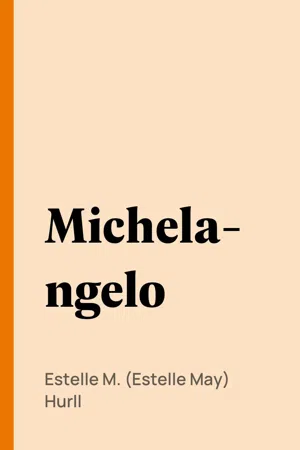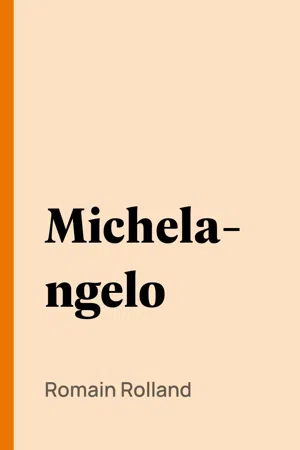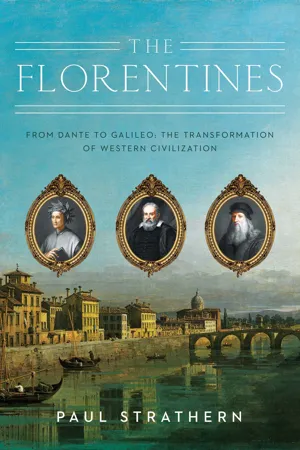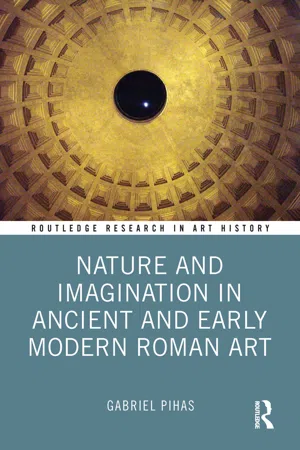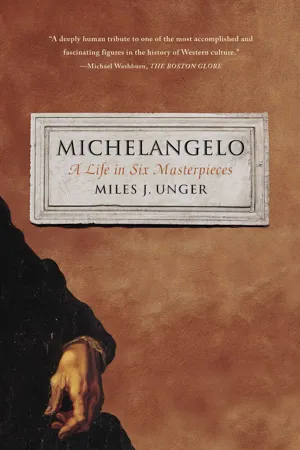History
Michelangelo
Michelangelo was a renowned Italian Renaissance artist known for his masterful works in sculpture, painting, and architecture. His most famous works include the statue of David and the ceiling of the Sistine Chapel in the Vatican. Michelangelo's contributions to art and his influence on subsequent generations have solidified his legacy as one of the greatest artists in history.
Written by Perlego with AI-assistance
Related key terms
6 Key excerpts on "Michelangelo"
- eBook - ePub
Michelangelo
A Collection of Fifteen Pictures and a Portrait of the Master, with Introduction and Interpretation
- Estelle M. (Estelle May) Hurll(Author)
- 2005(Publication Date)
- Perlego(Publisher)
His supremacy is acknowledged by all, but is understood by a few only. In the presence of his works none can stand unimpressed, yet few dare to claim any intimate knowledge of his art. The quality so vividly described in the Italian word terribilità is his predominant trait. He is one to awe rather than to attract, to overwhelm rather than to delight. The spectator must needs exclaim with humility, "Such knowledge is too wonderful for me; it is high, I cannot attain unto it." Yet while Michelangelo can never be a popular artist in the ordinary sense of the word, the powerful influence which he exercises seems constantly increasing. Year by year there are more who, drawn by the strange fascination of his genius, seek to read the meaning of his art. His subjects are all profoundly serious in intention. Life was no holiday to this strenuous spirit; it was a stern conflict with the powers of darkness in which such heroes as David and Moses were needed. Like the old Hebrew prophets, the artist poured out his soul in a vehement protest against evil, and a stirring call to righteousness. Considered both as a sculptor and a painter, Michelangelo's one vehicle of expression was the human body. His works are "form-poems," through which he uttered his message to mankind - eBook - ePub
- Romain Rolland(Author)
- 2010(Publication Date)
- Perlego(Publisher)
Blind, more or less, were all who lived around Michelangelo. Their too feeble eyes were dazzled by this sun which shone alone in that twilight of art, the night which was falling on Italy of the Renaissance. A long time after that sun had disappeared below the horizon the radiant glow still remained in the sky. Michelangelo enthralled Italian art.There is no comparison between the influence which he exerted and that of the other masters of the sixteenth century, Corregio and Raphael. However superior they may have been to their century, Corregio and Raphael only reflected its thoughts with more charm and grandeur. Michelangelo is outside of his time, alone, apart and colossal. He is like a great mountain which inspires in those who dwell at the foot an invincible desire to reach the top; and what men have ever existed who were less capable of climbing those austere and sublime{156} heights? All those effeminate artists of the decadence, intoxicated by his inspiration, attempted to express heroic ideas in their insipid works. They lost the sense of proportion which alone could have saved them. Instead of confining themselves to the little world of their own fancy which, though cold, could have been redeemed by sincerity, they attempted great subjects. A mass of forms, heroic figures and furious gestures that they had learned, were whirled about in their mind, uncontrolled either by greatness of intelligence or of heart.We must remember that Michelangelo lived through more than fifty years of the Golden Age of Italian art and, as happened in our own day to Victor Hugo, admiration for his works increased in proportion as they deserved it less. Even the factions that had been longest hostile to him—the school of Raphael, for instance—recognised his triumph. Perino del Vaga admits that all the painters worshipped him as their master, their leader and the god of drawing.[146]The independents, or those who boasted that they were, said as Cellini did in his sonnets:{157}"Just a leaf from thy crown, O divine Michelangelo, who alone art rich, who alone art immortal. That will suffice me and I shall have no desire for anything else, since for me that only is good and beautiful."Florence, his own country, more even than the rest of Italy gave him blind admiration. The Academy of Drawing, founded by Vasari, was a college of disciples and apostles. Since Michelangelo's great paintings were at Rome the Florentines copied chiefly his statues, devoting themselves principally, as Lanzi says, to ostentatiously showing "magna ossa lacertosque."[147] - eBook - ePub
The Florentines
From Dante to Galileo: The Transformation of Western Civilization
- Paul Strathern(Author)
- 2021(Publication Date)
- Pegasus Books(Publisher)
MichelangeloM ACHIAVELLI’S PRINCE COULD BE said to have taken Renaissance humanist thought to its logical conclusion. This was the ultimate individualism – but it was only for the ruler. In this way, it is ironically anti-humanist.Michelangelo would achieve much the same in his art. What can be more human than Michelangelo’s statue of David? Here is the ultimate symbol of humanity. He is strong, larger than life, yet naked and thus vulnerable. He is biblical, yet he is utterly a product of his humanistic era. He carries the sling which vanquished the Philistine giant Goliath. (What resonance in that simple fact!) And the Florentine people came to see him as a symbol of their struggle against their enemies – from the Medici to the overwhelming power of Rome.Like Machiavelli, Michelangelo’s formative years would be spent during the period when Savonarola held sway in Florence. Yet if this was the common heritage out of which they grew, which nurtured them both, their reactions to it could not have been more disparate. As personalities, Machiavelli and Michelangelo would prove almost polar opposites. Michelangelo was earnest, proud, irascible and obsessively hard-working. He also had a profound belief in God, and it is from Michelangelo that we learn something of Savonarola’s bewitching powers.As a young man, Michelangelo was in the habit of honing his sculpture skills in the gardens set up by Cosimo de’ Medici close by the monastery of San Marco. In the midst of his labours, he frequently heard Savonarola preaching to his fellow friars beneath the damask rose tree in the monastery garden across the road – an experience he would never forget. Michelangelo’s character had been imbued with a deep spirituality from the earliest years of his childhood, and he soon found himself listening intently to what Savonarola was saying. But more than this, Michelangelo found himself so enchanted by the manner in which the ‘little friar’ spoke that more than sixty years later he would confide to his favourite pupil, Ascanio Condivi, that ‘he could still hear [Savonarola’s] living voice ringing out in his mind’. - Gabriel Pihas(Author)
- 2022(Publication Date)
- Routledge(Publisher)
What is the interest in possessing these mere ideas for positions of the hands, or about a tentative framing of a figure within a geometrical schema in a discarded plan for a fresco? It is not simply a matter of having an image of something beautiful, nor is it a desire to have an accurate image of a subject, nor is it a desire for artwork that has a particular ritual value or some other use value. Instead, what suddenly matters is not simply the craft, but the artist’s creative signature. People above all wanted to have “a Michelangelo”. Not accidentally, Michelangelo claimed to have chosen the content in the Sistine ceiling on his own, rather than to have followed a program given to him by a Vatican prelate. Contemporaries thought Michelangelo capable of his own ideas because they thought he had a creative power of a type that is not looked for in artisans. The blend of the theology of creation and the creativity of art in the Sistine Chapel reflects this moment in history when the artists became thinkers, and not just technicians. It is at this point when a mere sketch is vaunted as “disegno” and great skill becomes “terribilitá”. The idolizing of Michelangelo which critics sometimes rightly lament is merely the first case of the valuation of the artist in general that typifies modern culture. It should be clear by now that Michelangelo’s interest for moderns and for us is not only about the history of art. At its root was a new way of thinking about human beings, technology, and nature. Human skill was impressive when it flaunted its unnatural quality, presenting what was overly complex or seemingly impossible. It suggests the freedom of art to ignore the model of the naturalist and to paint instead from the imagination. The twisting body of Michelangelo’s 1532 statue of Victory is a famous example of such a victory of art over nature, foundational in the development of mannerism, where creativity and imagination replace the imitation of nature- eBook - ePub
Michelangelo
A Life in Six Masterpieces
- Miles J. Unger(Author)
- 2014(Publication Date)
- Simon & Schuster(Publisher)
The fruits of these late-night sessions are apparent in almost all Michelangelo’s subsequent works. With the possible exception of Leonardo da Vinci—whose investigations were as much scientific as they were artistic—Michelangelo possessed an unmatched understanding of human anatomy. His nudes are not superficial approximations of the human form but seem to pulse with an inner life, an illusion conjured by his unmatched knowledge of the dynamic mechanism of the human body. The articulation of joints, the structure of muscle and tendon working together to produce motion, the branching networks of veins suffusing flesh with vital nutrients and nerves linking mind to body—all these are articulated with a deep understanding of how each contributes to the whole.Michelangelo’s anatomical studies were not simply a means to an end. His two years at the Medici Palace had confirmed his faith in the nobility of art, but with prestige came responsibility. To fulfill its promise, art must do more than reflect the appearance of things: it must delve beneath the surface to deliver profound truths. Leonardo began his Paragone by asking whether or not painting was a science, answering in the affirmative by employing an argument that must have appalled his more bookish colleagues: “[A]ll sciences are vain and full of errors that are not born of experience, mother of all certainty, and that are not tested by experience, that is to say that do not at their origin, middle, or end pass through any of the five senses.” From this he derives the postulate that “painting, which arises in the mind but cannot be accomplished without manual operation,” is more science than craft since it is, first and foremost, a means of investigating the world through the visual faculty, the most powerful tool we have for apprehending reality.Though Michelangelo’s interests were never as purely academic, or nearly as wide-ranging, as Leonardo’s, he shared with his older colleague a conviction that art is a tool for making sense of the world. Studying the body with the precision of an anatomist, uncovering its deep structure, allowed Michelangelo to probe human nature more thoroughly than any artist before him and to create figures in which every gesture expresses an inward state and every pose is fraught with possibility. - eBook - ePub
- William Wallace(Author)
- 2013(Publication Date)
- Routledge(Publisher)
In the present case there would have occurred one of these infinitely rare conjunctions of chance and opportunity and talent and tradition, together with physical impermanence and enduring fame. In the early years of the 16th century Florentine art was approaching its apex. The long line of sculptors and painters which had included Giotto in the 13th and 14th centuries had gone on to produce an amazing galaxy on the 15th. Donatello, Masaccio, Fra Angelico, Lippo Lippi, Verrocchio, Antonio Pollaiuolo and Botticelli had all flourished within a period of little more than half a century. At the end of it the Medici dynasty which had been a patron to many of them had been temporarily overthrown and a democratic government set up. As a result of this a vast hall had been built on to the back of the Palazzo Vecchio—on the model of the great room in the Doge’s Palace at Venice—as a meeting place where all responsible citizens of Florence should participate in governing it. The most conspicuous feature of the decoration was to consist of two colossal mural paintings of battle. One of these was entrusted to Leonardo, the other to Michelangelo.There is no need to stress the opportunity. The size of the paintings alone and their situation at the centre of the affairs of the city represented a commission which would only come the way of an artist once in several life times. The type of commission was also a challenge, since there was no tradition of battle pieces of this size. Uccello’s series in Palazzo Medici—Riccardi was much smaller, while the largest space in the hall at Venice was filled, then as now. by a painting not of a battle but of paradise. As to the artists. Leonardo, in his early fifties, had recently returned to his native city after an absence of many years, bringing with him the fame he had gained at Milan. He evidently exercised an irresistible personal glamour so that whatever he did was news. And at this time he had recently drawn a cartoon of the Madonna and Child with S. Anne which had astounded Florence. As to Michelangelo, though he was more than 20 years younger, he had likewise recently returned to Florence covered with glory earned outside his native city. His Pietà in S. Peter’s, Rome had been the first great success of his life. On his return to Florence he was clearly the coming man who could be set up against the great Leonardo. Indeed, the element of rivalry in the battle paintings seems to have existed on all levels from the beginning. Leonardo was probably the first who was commissioned. Certainly he started work first. We do not know exactly when it was decided that Michelangelo should be entrusted with the other painting, but by the time he in his turn started work—at the end of the year 1504—he would already have turned the balance of popular esteem in his favour. For a few months earlier, in the summer of that year, his gigantic marble David
Index pages curate the most relevant extracts from our library of academic textbooks. They’ve been created using an in-house natural language model (NLM), each adding context and meaning to key research topics.
